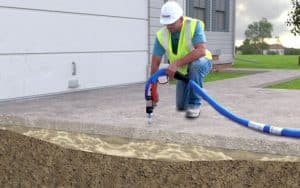As a property owner, a person can come across a bunch of structural issues that require urgent care, such as leaking roofs or seeping basements. But then there are some warp and woof problems, such as sunken driveways that homeowners deem inessential and put fixing those on the back burner. Doing so seems like the right thing to do because it’s not like a cracked concrete slab would collapse the house; however, if you let the issue persist, it’ll get worse and cost a pretty penny in repairs. Therefore, to avoid breaking your bank account later, you should consider fixing the problem before it gets dire.
Tackling a worn-out concrete slab early is much easier as it will only require leveling. But if you wait and it becomes more damaged, fixing it would mean replacing the entire block, which means spending a hefty amount of money.
Concrete Leveling
Concrete leveling, also known as slab jacking, is a quick yet effective way of repairing a broken slab that involves drilling holes into the cement block and filling them with polyurethane foam or cement mix. It may seem too simplistic of a repair method to solve such a seemingly major issue, but it works wonders if done correctly.
Getting To Grips With Concrete Leveling
To understand the process of concrete leveling, looking at the cause of sunken slabs is essential. The concrete blocks in your driveway lie on the soil beneath it. As long as the mud remains compact and holds its dense texture, the slab resting on it stays upright. But when the underlying soil loses compaction and is unable to maintain adhesion, the concrete above it begins to droop, eventually cracking.
Naturally, in order to fix a sunken concrete slab, a craftsperson must fill the gaps between the mud underneath it. And that is precisely what concrete leveling does, pushing up the damaged piece of pavement.
Over time natural elements such as increased moisture, frost heave, and weak bearings can affect the integrity of the earth below the ground, causing it to start loosening up, giving way to air spaces crumbling the concrete block above. Ultimately the slab sinks, cracks, and degrades, becoming unsightly and a nightmare to drive a car over.
Looking at a sunken slap, your first approach to fixing it would be replacing the entire piece of concrete. But that should be the last resort when the damage becomes unsalvageable. As mentioned above, in the early stages, a sunken concrete slab can be very easily fixed by squirting in some polyurethane foam or cement slurry under the ground.
Hire a professional concrete leveling contractor and; they’ll drill holes in the broken slab and pump in the concrete mix, filling the gaps in the soil.
Once the spaces are filled, the sunken block of concrete automatically rises.
If you get concrete leveling done in time, you’ll save a ton of money and have a durable pavement. On the contrary, if you choose to replace a broken concrete slab, you will not only lose a lot of money at the time of replacement but also later when you’ll inevitably come across cracks on the new concrete slab. Because the cause of concrete damage is still present, no matter how many slabs you replace, the new ones will keep getting damaged because the soil will break away and develop voids. But with slab jacking, you will fix the underlying problem once and for all, thereby mitigating the chances of future damage.
The Bottom Line
Don’t waste your hard-earned money on replacing slabs just because you have heard of that repair method. If you don’t want to have something unfamiliar done to your pavement, read about it, hire a reputable company and make a wise decision that’ll save you money and give you long years of intact concrete slabs.



